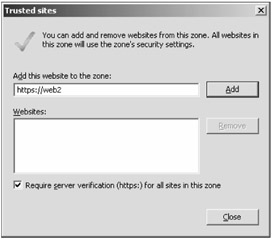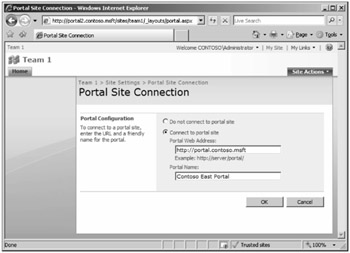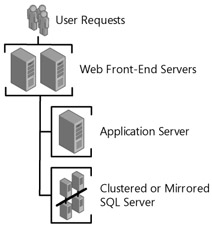Applications and Services
Windows SharePoint Services and SharePoint Server provide an integrated group of applications that can be managed from a central location. Understanding what each of these applications does, and in which product feature set it resides, is important to a successful installation and a positive administrative experience. Take the time to learn where product suite applications and services reside, before inserting the installation media and clicking next. Don't let the large feature set intimidate you; use only what you need in the beginning and add applications as your requirements mandate.
Operating System Services
The Windows Server operating system provides the foundation for all SharePoint products. The required operating system services are described here:
-
Microsoft .NET 1.0 (if supporting legacy 1.0 Web Parts) Although .NET 1.0 was required for the previous versions of SharePoint products, it is optional when installing Windows SharePoint Services and SharePoint Server. It is only required if you wish to support legacy Web Parts from Windows SharePoint Services 2.0 or SharePoint Portal Server 2003.
-
Microsoft .NET 2.0 Windows SharePoint Services, and therefore SharePoint Server, was built on .NET 2.0 and is required to be installed prior to Windows SharePoint Services or SharePoint Server.
-
Microsoft .NET 3.0 The newest version of the .NET framework provides many new features; the most notable for SharePoint technologies administrators is the ability to create customized workflows. With .NET 3.0 you can connect your business processes, such as content approval, to out-of-the-box (OOB) workflows in SharePoint Server. These OOB workflow patterns are only available with SharePoint Server. In addition, you can create and reuse custom workflows with SharePoint Designer 2007. For organizations desiring the richest business processes available, Visual Studio 2005 gives developers the ability to create highly customized workflows and corresponding Web pages.
-
Internet Information Services Internet Information Services (IIS) is the Web service that hosts all of the SharePoint Web applications on its secure and easily managed platform. IIS 6.0 or IIS 7.0 can successfully handle SharePoint Web traffic, but IIS 7.0 improves the manageability of Web applications and can reduce the surface attack area presented to hackers. This book refers to IIS generally, and versions are only pointed out where they make a difference in configuration.
-
Internet Explorer 6.0 or later Internet Explorer 6.0 or later is required to manage your standalone SharePoint server or server farm. If you have a customized Internet Explorer installation, you may need to add your Central Administration URL and other namespaces to the Intranet zone or Trusted Sites zone as shown in Figure 1-3.

Figure 1-3: Always add the Central Administration URL to the Intranet zone or Trusted Sites zone in your browser.
Windows SharePoint Services 3.0
Windows SharePoint Services 3.0 provides all of the core functionality, such as backup/restore and scalability. Windows SharePoint Services gives you the ability to collaborate with team workspaces, calendars, tasks lists, and alerting. It also offers a rich custom development environment to build Web-based applications. Windows SharePoint Services provides servers with the ability to communicate with Office clients, such as Excel, Word, PowerPoint, Outlook, InfoPath, Project Professional, and third-party applications. It is a free download for Windows Server 2003 license holders and should also be available to license holders of the newer Windows Server version codenamed "Longhorn." The investment areas of the Windows SharePoint Services are described here.
-
Core workspace platform Windows SharePoint Services provides the platform for users and developers to customize and extend SharePoint technologies. By providing the object model, Windows SharePoint Services allows for browser-based database manipulation including creating, reviewing, deleting, managing, alerting and schema management. It also allows rich customization, portability of code, and a single platform for development, collaboration, and deployment, Organizations with Internet and Intranet Web sites can save a significant amount of money because Intranet and Internet development can be performed in the same application programming environment, while still using all of the benefits of Windows SharePoint Services. In addition, Windows SharePoint Services installation creates the configuration database that provides the foundation for scaling to a Windows SharePoint Services or SharePoint Server farm.
Note A farm consists of multiple servers that host or share the same configuration database: the config DB. This centralization of a configuration database allows for fast and easy deployment and repurposing of servers, giving you the ability to right-size your implementation as needed. As shown in Chapter 2, "Deploying SharePoint Products and Technologies," you can move services between farm servers without reinstalling software or provisioning additional servers. Think of the config DB as the farm's "Registry." This Registry is the heart and soul of a server farm and allows scaling of Web and application servers. A server is a member of a given farm when it shares a common config DB. If a server attaches to a different config DB, it is in a different farm. If the config DB is the server farm's heart and soul, then the SPTimer service is its heartbeat. The SPTimer service is installed with every server on which you install the binaries. It provides the communication between all services and servers in the farm for timed events, such as backups, workflow events, and alerts. The SharePoint Administration Service (WSSADMIN) propagates all changes in the config DB to farm servers as necessary.
-
Next generation collaboration Windows SharePoint Services also provides you with integrated collaboration and full Outlook 2007 integration, including two-way calendaring, tasks, offline document, and mail-enabled document libraries. Mail-enabled document libraries capture e-mail discussions by enabling indexing of critical institutional (tacit) knowledge. The user interface now includes full breadcrumb trails and tabs for easier navigation. These tabs and trails previously required extensive programming or third-party Web Parts.
Tip From Site Actions > Site Settings, you must enable the Portal Connection for breadcrumb trails to lead back to the portal root (see Figure 1-4).
-
Easy extensibility for SharePoint Server application servers Windows SharePoint Services provides the necessary foundation for SharePoint Servers and allows them to be extended and customized.

Figure 1-4: You must manually configure Portal Site connections to enable breadcrumb trails to the Portal URL.
For basic collaborative solutions, Windows SharePoint Services provides the core site model. For workgroups or small organizations, this product offers a free alternative to expensive third-party collaboration solutions if you already own Windows Server 2003 or later. In addition, you are guaranteed complete operating system compatibility with your Windows Server, which is a compelling reason to use Windows SharePoint Services as your Web-based collaboration solution. The following services are provided by Windows SharePoint Services:
-
Application management Windows SharePoint Services provides the Central Administration Web interface that is used by all SharePoint 2007 Products and Technologies.
-
Site model Site collections are at the root of the site model and are a collection of one or more sites. A site contains users, lists, document libraries, Web pages, content types, and more. All site item storage is via lists and document libraries. Every Web page, Web Part, document, task, or calendar item is a list item. This storage format allows for rich customization and content linking, as well as versioning of all content. In addition, Windows SharePoint Services 3.0 and SharePoint Server 2007 include the much-anticipated capability of a Recycle Bin. The Recycle Bin usually prevents the permanent deletion of objects; with this feature, it is no longer necessary to go to database backups for item-level deletion. Content types are also provided by the site model and allow for metadata tagging of almost any object type. Based on this metadata, you can manipulate objects via workflows or information management policies effecting extensive business process management.
Note Almost every object in Windows SharePoint Services and SharePoint Server 2007 is a content type. A content type is a collection of settings, such as metadata and a document template, that can have policies and workflow attached for use across multiple sites in a site collection. This allows management at the site collection level of list items, such as records or Web pages. Used in conjunction with document libraries, for example, you can now have multiple content types in a single document library or schedule Web content for deployment. Content types are covered in detail in Chapter 10, "Configuring Office SharePoint Server Enterprise Content Management."
-
Customization SharePoint Server is designed to enable extensive, user-friendly customization. Users and administrators can add many customizations without the aid of developers through the native browser-based graphical user interface (GUI) or SharePoint Designer 2007. Virtually unlimited customization can be accomplished using ASP.NET. Custom code written as Web parts are reusable, allowing developers to create new functionality that can be used by administrators and users across multiple sites.
-
Web applications At the root of Windows SharePoint Services and SharePoint Server is the Web application. In previous versions the Web application was also known as a Virtual Server. Since the release of Microsoft Windows Virtual Server R2, the name has been changed to eliminate confusion. A Web application is created from Central Administration and associates an IIS Virtual Server with a content database created on your SQL Server. Remember that this Web application is an empty shell and contains no site collections by default. You are prompted to create a site collection during initial installation, and you should complete it then. Figure 1-5 shows the relationship among site collections, Web applications, and content databases.
-
Collaboration The collaboration features provided by Windows SharePoint Services include Office 2007 integration, limited Office 2003 integration, calendaring, tasks, and e-mail integration. Both inbound and outbound e-mail are now integrated. This integration creates a seamless connectivity, decreasing the learning curve for new users and speeding the time to achieve effective collaboration.
-
Security Windows SharePoint Services also leverages the operating system and database system security and continues through IIS, Web application, and site collection levels. This version now provides per-item security in site collection lists and document libraries. Subsites (sub-Webs) also can inherit permissions or use their own as in the previous version. Security at the site collection or item level is of little use if care isn't taken at the Web server. Because this version of Windows SharePoint Services is built on .NET 2.0 and .NET 3.0, you now can use .NET Pluggable authentication to authenticate users. This feature is extremely useful when Extranet and Internet users are not authorized for internal organizational Active Directory accounts. You may maintain a third-party database for usernames and password and authenticate with pluggable authentication. As you install and learn this product, be aware that the user interface (UI) is "security trimmed." Users (including you) only see the portions of the UI that permissions allow.
-
Windows SharePoint Services search Windows SharePoint Services provides a search engine similar in appearance to the SharePoint Server "Big Brother" search service. Windows SharePoint Services uses this service for all searching, but it is limited to the site collection from which you are searching. After installing SharePoint Server, the Windows SharePoint Services search service is used for indexing Help files only.
-
Scalability Because the config DB is a function of Windows SharePoint Services; all Office Servers rely on it to provide scalability. If you were familiar with the previous version, you know there were limitations with the configuration topology of your farm. This later version lifts the majority of restrictions. However, with this freedom of configuration also comes the possibility for mistakes. Take your time, do research, and make an educated decision about the correct topology to use. Figure 1-6 is a suggested example of a medium server farm.

Figure 1-5: Site collections exist within Web applications. Web applications store their content in associated content databases.

Figure 1-6: A medium server farm introduces SQL Clustering for database redundancy, dedicated Web front-end servers for user requests, and a middle tier of application servers for Excel Calculation Services, Query, and Indexing.
In Figure 1-6 there are two Web front-end servers (WFEs) serving Web content, search queries, and proxying Excel Calculation Services requests The middle tier is a single server providing high-value, CPU-intensive applications like indexing and Excel Calculation Services. You could have several middle-tier servers or WFEs if needed. In this example, the SQL Server third tier is a cluster providing high availability. Whatever size farm topology you begin with, remember it is easy to provision additional servers and grow as your requirements change. You can also detach servers from a config DB and attach to another farm when needed. This functionality is very useful to organizations looking to lower costs when transitioning custom code from development to test.
Microsoft Office SharePoint Server 2007
SharePoint Server 2007 builds on the core platform services provided by Windows SharePoint Services and adds rich functionality, such as Business Process Management, Content Management, Portals, Search, Business Intelligence, and Shared Services. In contrast to the previous version, SharePoint Server 2007 extends the existing familiar interfaces, easing the transition from Windows SharePoint Services. The following components are included in SharePoint Server 2007 Standard Edition:
-
Rich search and indexing functionality SharePoint Server search adds functionality far beyond what is provided by Windows SharePoint Services. Its ability to crawl external content, such as line-of-business systems, Exchange Public Folders, Lotus Notes, generic Web sites, remote SharePoint sites, and file shares, provides a solid reason to move to SharePoint Server 2007. This version also provides extensive customization capabilities using the native, in-browser editor to fine-tune your search results and experience.
-
My Sites (personal portals) My Sites functionality represents a noteworthy improvement in SharePoint Server 2007. Unlike SharePoint Portal Server 2003 where My Sites shared a common home page, My Sites are now truly a "personal portal" providing rich customization and one-to-many collaboration. With My Sites, users have the ability to create meeting workspaces from Outlook calendaring; store, collaborate, and version files; provide details of specialties for indexing; create blogs and wikis; and much more.
-
Corporate and Internet presence portals One of the most-asked questions about SharePoint Server 2007 is "Where did the portal go?" This question is a fair one. The product team wanted to make SharePoint Server 2007 more than just another portal product so it created a collaborative portal in this version. It is a site collection with a portal template (Publishing Collaboration Portal) applied. This can be customized by users so that the information is timely and relevant to them. Because portals are largely user specific, portal functionality is provided via Web parts. These Web parts, in addition to almost every portal feature, can be targeted to a specific audience.
There is also an Internet Publish portal template that enables you to easily create, modify, and maintain an Internet presence site. It includes a built-in editor and can be designed and deployed by the average SharePoint power user.
-
Business Data Catalog The Business Data Catalog (BDC) allows you to connect to third-party line-of-business (LOB) applications, such as SAP, Siebel, and PeopleSoft. The BDC enables you to amalgamate content from LOB systems without writing custom code. Although it presents a leap forward in LOB connectivity, it does require a custom application definition and expertise in its creation.
For more information on the BDC, visit http://msdn2.microsoft.com/en-us/library/ms551230.aspx.
In addition to the services provided by the Standard Edition, SharePoint Server 2007 Premium Edition adds Excel Calculation Services and InfoPath Forms Server.
-
Excel Calculation Services With Excel Calculation Services you can render Excel workbooks in a browser. Excel Calculation Services offer in-browser input and an ability to hide formulas from the end user. The user also now can take a snapshot of the current view of the spreadsheet without gaining access to the entire workbook. Allowed clients are Microsoft Excel 2007, supported Web browsers, and custom applications. Although ECS offers functionality far beyond what was previously capable, it does not allow authoring of Excel workbooks in the browser.
-
Office Forms Server InfoPath Forms Server is not covered in any detail in this book. Office Forms Server is primarily a developer tool and its administration isn't difficult. The advantage of SharePoint Server 2007 is its single management interface used to manage Office Forms Server and perform disaster recovery. Forms created from the InfoPath Office client are automatically rendered via a friendly interface in the browser. For more information on InfoPath Forms Server visit http:/www.microsoft.com/infopath.
EAN: 2147483647
Pages: 110